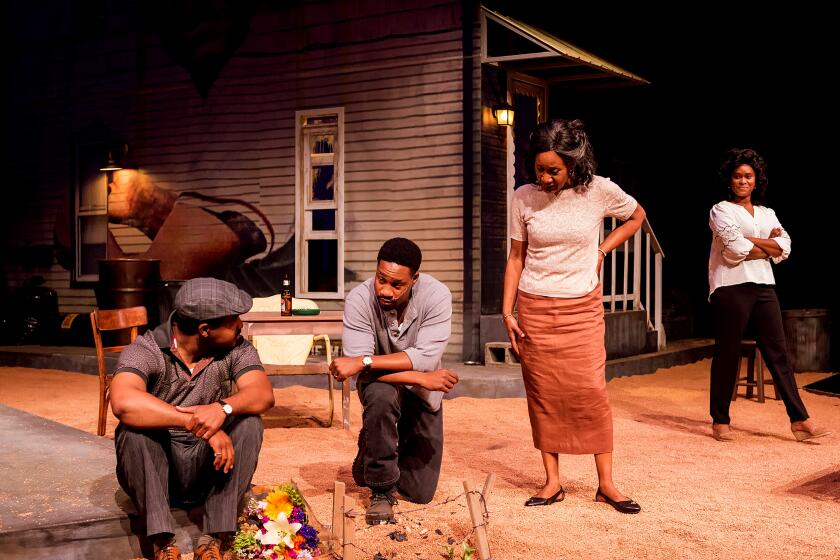The groove where jazz and dance music meet
The cavernous dance club in downtown L.A. is hopping, and the weekend is still a day away. The club is ordinarily a hotbed of thumping house music, but tonight, the headliner — Houston-born jazz pianist and bandleader Robert Glasper — is switching things up.
Behind a bank of keyboards, Glasper leads his quartet through a restless swirl of searching piano melody, causing the crowd to sway under the hazy colored lights. As the song gathers into focus, one musician begins repeating an unmistakable, 40-year-old refrain, his voice shaded by electronics: “A love supreme…. A love supreme…”
This introduction of John Coltrane (or at least the sounds he inspired) into a modern dance club was a gratifying, chocolate-in-my-peanut-butter moment, but it isn’t a singular event. The night’s opener, British electronic producer and DJ Quantic, made for an easy transition to Glasper, with a live band swerving through funk and soul-jazz.
As both artists expertly blended genres to reach new audiences, their sound pointed to that natural link between jazz and EDM, or electronic dance music.
With fans turning out by the thousands for sprawling dance festivals in celebration of the beat, it’s become clear that lyrics are no longer necessary to pull in a younger crowd.
Simply put, instrumental music is becoming something less exotic. EDM, which is often lyricless or dependent on a vocal loop that serves more as an instrument than a worded sentiment, is now one of the top-grossing genres of the music world.
As fans of Miles Davis and Charlie Parker learned before them, listeners drawn to the sounds of DJs such as Tiësto and Deadmau5 know that lyrics sometimes get in the way of expressing feelings in music. And it bears repeating: Jazz began as dance music.
And with artists such as Quantic and Glasper folding strains of jazz into a mix that sounds natural on the dance floor, there’s growing potential for EDM to serve as a gateway drug into jazz.
Shared echoes between electronic music and improvised instrumental music have been building for years, with that shared ground most consistently explored in Europe. Squarepusher brought fretless, jazz fusion-ready bass to what was unfortunately known as Intelligent Dance Music in the ‘90s, and London-born electronic musician Kieran Hebden followed in the early years of the next decade in exploring abstract, jazz-like structures with a mix of programmed and live instruments for his project Four Tet.
Hebden further underscored the connection in a series of infectious collaborations with the late jazz drummer Steve Reid, who had previously backed Sun Ra, Ornette Coleman and Miles Davis. Reid died in 2010 after recording four albums with Hebden; the pairing released a live album late last year with fiery Swedish saxophonist Mats Gustafsson.
A German techno producer who began his career as a drummer in the ‘90s, Moritz von Oswald has said he treats jazz as a “funny valentine” with his improvisation-friendly trio, which also features fellow producers Vladislav Delay and Max Loderbauer. The group recently released its fourth album, “Fetch,” which leans more heavily on a stable beat than previous works, but its opening track, “Jam,” features an echoing trumpet melody from Sebastian Studnitzky that results in a song resembling something from “In a Silent Way” recorded in a haunted mainframe factory.
Oswald’s bandmate Loderbauer also tapped the catalog of the European jazz and classical label ECM to arresting effect on last year’s double album of remixes, the atmospheric “Re: ECM.” And this only scratches the surface of European jazz artists who experiment with electronic textures in various forms, including Nils Petter Molvaer, Arve Henriksen and the late Esbjörn Svensson’s trio, E.S.T.
Some U.S. hybrids have sprung out of the so-called jam band scene, which shares a bond with rave culture, in that in-the-moment live performance is valued over hearing the music anywhere else.
Somewhat goofily named groups such as Sound Tribe Sector 9 and the Disco Biscuits neatly straddle both worlds, with the latter even sharing a bill with EDM noise king Skrillex at the group’s annual Camp Bisco festival in July.
Marco Benevento, a Berklee-educated keyboardist frequently lumped into the jam-oriented scene though his appearances in “Icons Among Us,” a documentary on the next generation of jazz, more accurately point to his roots, and freely draws from a variety of genres. His latest album, “Tigerface” (due in September), opens with “Limbs of a Pine,” which features an irresistibly driving, joyful synthesizer groove punctuated by a nonsensical vocal sample. It’s a 31/2 -minute blast of swirling, tribal future-disco that could just as easily blast out of a festival dance tent.
Here in L.A., the Brainfeeder label founded by Steven Ellison (a.k.a. Flying Lotus) marks perhaps the most intriguing flash point in the country for the intersection of beat music and this new varietal of jazz. In 2010, Ellison bridged the gap to immersive effect with “Cosmogramma,” a bewitching album dedicated to his great aunt, Alice Coltrane (the follow-up, “Until the Quiet Comes,” is due Oct. 2). Though Ellison’s primary instrument is the laptop, his album included contributions from cousin Ravi Coltrane on saxophone, and live performances have expanded to a full ensemble that merges instrumental hip-hop with “Bitches Brew”-era fusion.
Brainfeeder has already made an indelible impact on the local music scene with its hit Low End Theory night at the Airliner, but its future seems equally intriguing. Last year, Ellison’s virtuosic bassist, Stephen Bruner (better known as Thundercat), released an album soaked with R&B;, yacht rock and ‘80s jazz, as did rising young keyboardist Austin Peralta, who went from releasing standards records with Ron Carter and Billy Kilson as a teen to exploring the outer limits of space-jazz with saxophonists Ben Wendel and Zane Musa on “Endless Planets.”
Another recent signee, Kamasi Washington, is a ferocious local saxophonist who performs as part of the Gerald Wilson Orchestra. Where his music goes under Brainfeeder’s imprint is unknown, but it’s no doubt bound for where music of all kinds inevitably starts: In a room, in front of a crowd, and moving forward, no matter what you call it.
More to Read
The biggest entertainment stories
Get our big stories about Hollywood, film, television, music, arts, culture and more right in your inbox as soon as they publish.
You may occasionally receive promotional content from the Los Angeles Times.







